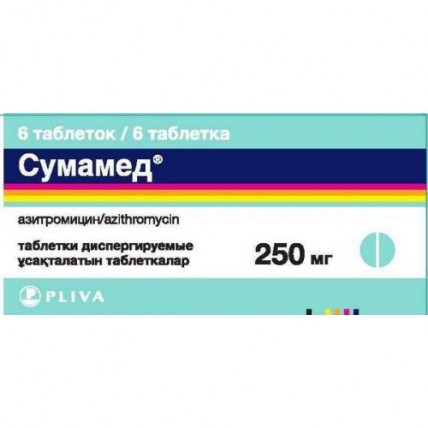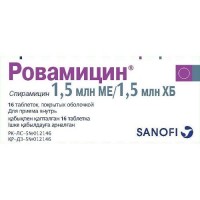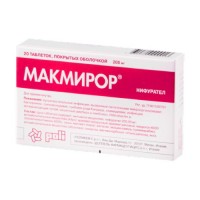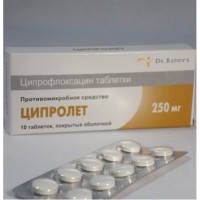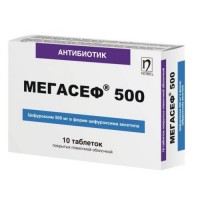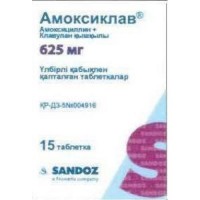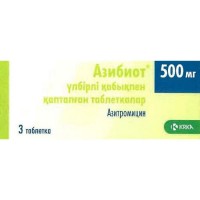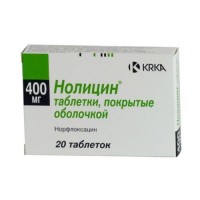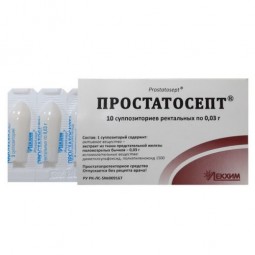Sumamed® 250 mg (6 dispersible tablets)
- $41.30
Dosage form
Dispersible tablets 250 mg
Structure
One tablet contains the active substance - azithromycin dihydrate 262.055 * mg (equivalent to 250 mg of azithromycin)
Sensitivity table
Aerobic gram-negative microorganisms
Haemophilus influenzae *
Moraxella catarrhalis *
Other microorganisms
Chlamydophila pneumoniae
Chlamydia trachomatis
Legionella pneumophila
Mycobacterium avium
Mycoplasma pneumoniae *
Types of microorganisms for which problems associated with acquired resistance are possible
Aerobic gram-positive microorganisms
Staphylococcus aureus *
Streptococcus agalactiae
Streptococcus pneumoniae *
Streptococcus pyogenes *
Other microorganisms
Ureaplasma urealyticum
Microorganisms characterized by primary resistance
Aerobic gram-positive microorganisms
Staphylococcus aureus - methicillin-resistant and erythromycin-resistant strains
Streptococcus pneumoniae - penicillin-resistant strains
Aerobic gram-negative microorganisms
Escherichia coli
Pseudomonas aeruginosa
Klebsiella spp.
Anaerobic gram-negative microorganisms
Bacteroides fragilis group
* The clinical efficacy of the drug is confirmed by the isolation of sensitive microorganisms if the drug is used for approved clinical indications.
Indications for use
Sumamed® is indicated for the treatment of the following infections caused by microorganisms sensitive to azithromycin:
- Acute bacterial sinusitis (properly diagnosed);
- acute inflammation of the middle ear of bacterial etiology (properly diagnosed);
- pharyngitis / tonsillitis (streptococcal infections);
- exacerbation of chronic bronchitis (properly diagnosed);
- community-acquired pneumonia of mild to moderate severity;
- infections of the skin and soft tissues of mild to moderate severity, for example, folliculitis, phlegmon and erysipelas;
- erythema migrans (first stage of Lyme disease) if first and second line antibiotics (doxycycline, amoxicillin and cefuroxime axetil) are contraindicated (use for erythema migrans).
- uncomplicated urethritis and cervicitis caused by Chlamydia trachomatis.
Method of administration and dosage
Dosage
Sumamed® dispersible tablets should be used as a single daily dose. The duration of treatment for various infectious diseases is given below.
Adults, children and adolescents weighing 45 kg and more:
The total course dose is 1500 mg, divided into 500 mg once a day for 3 days. Alternatively, the same total course dose (1500 mg) can be applied over a period of 5 days - 500 mg as a single dose on the first day, followed by a dose of 250 mg once a day on days 2-5.
In the treatment of uncomplicated sexually transmitted diseases caused by Chlamydia trachomatis, a single dose of 1 g is prescribed.
In the treatment of erythema migrans, the total course dose of azithromycin is 3 g and is administered according to the following scheme: 1 g per day 1, and then 500 mg every day from day 2 to day 5, once a day.
Children and adolescents weighing less than 45 kg:
Typically, the recommended dose is 10 mg / kg / day; is used as a single dose for 3 consecutive days (maximum dose - 30 mg / kg). Alternatively, the same total course dose can be divided into 5 days; while on the first day the drug is used at a dose of 10 mg / kg, and in the next four days - at a dose of 5 mg / kg / day. The maximum value of the total course dose in children is 1500 mg.
Other pharmaceutical forms of the drug may be better suited to ensure the correct dosage in children of a certain body weight.
Elderly persons:
In older people, the same dosage is used as in younger adults. Since there is often a predisposition to cardiac arrhythmias among older patients, special care must be taken due to the risk of cardiac arrhythmias and pirouette-type ventricular tachycardia.
Renal dysfunction:
In patients with mild to moderate renal impairment (GFR 10–80 ml / min), dose adjustment is not required. Care must be taken when prescribing azithromycin in patients with severe renal impairment (GFR <10 ml / min).
Liver dysfunction:
In patients with impaired liver function of mild or moderate severity (class A or B on the Child-Pugh scale), dose adjustment is not required. Since azithromycin is metabolized in the liver and excreted in the bile, azithromycin should be used with caution in patients with serious liver disease. Studies on the use of azithromycin in these categories of patients have not been conducted.
Mode of application
The tablet should be dissolved in a sufficient volume of liquid, for example, water, apple or orange juice (at least 30 ml), stirring until a highly dispersed suspension is obtained. After the patient has swallowed the suspension, the residue on the vessel walls must be redissolved in a small volume water and swallow. The dissolving tablets can be taken with or without food.
Side effects
The following are adverse reactions identified during clinical trials and post-marketing surveillance, sorted by system organ classification and frequency. Adverse reactions identified during the post-registration use of the drug are shown in italics. The phenomena are conventionally grouped by frequency as follows:
- Very often (≥ 1/10), Often (≥ 1/100 to <1/10), Uncommon (≥1 / 1000 to <1/100), Rarely (≥ 1/10 000 to <1 / 1000), Frequency unknown (cannot be determined from available data).
Within each frequency group, adverse events are ranked in descending order of severity.
Often (≥ 1/100 to <1/10)
- nervousness, insomnia
- headache
Uncommon (≥1 / 1000 to <1/100)
- candidiasis, vaginal infections, pneumonia, fungal infections, bacterial infections, pharyngitis, gastroenteritis, respiratory system disorders, rhinitis, oral candidiasis
- leukopenia, neutropenia, eosinophilia
- angioedema, hypersensitivity reactions
- anorexia
- dizziness, drowsiness, dysgeusia, paresthesia
- visual impairment
- disturbances from the ear, dizziness
Rarely (≥ 1/10,000 to <1/1000)
- excitement
Frequency unknown
- pseudomembranous colitis
- thrombocytopenia, hemolytic anemia
- anaphylactic shock, including edema (in rare cases leading to death)
- aggression, anxiety, delirium, hallucinations
- fainting, convulsions, hypesthesia, psychomotor hyperactivity, anosmia (loss of smell), ageusia (loss of taste), parosmia, severe pseudoparalytic myasthenia gravis
- hearing impairment, including deafness and / or tinnitus
Adverse reactions that are possibly or likely associated with the use of azithromycin (according to clinical trials and post-marketing surveillance):
Very often (≥ 1/10)
- diarrhea
Often (≥ 1/100 to <1/10)
- vomiting, abdominal pain, nausea
- a decrease in the number of lymphocytes, an increase in the number of eosinophils, a decrease in the concentration of bicarbonate in the blood, an increase in the number of basophils, an increase in the number of monocytes, an increase in the number of neutrophils
Uncommon (≥1 / 1000 to <1/100)
- heart palpitations
hot flashes
- shortness of breath, nosebleeds
- constipation, flatulence, dyspepsia, gastritis, dysphagia, bloating, dry mouth, belching, ulceration of the oral mucosa, salivary hypersecretion
- rash, itching, urticaria, dermatitis, dry skin, hyperhidrosis
- osteoarthritis, myalgia, back pain, neck pain
- dysuria, pain in the kidney area
- metrorrhagia, testicular disorders
- edema, asthenia, malaise, increased fatigue, edema of facial tissues, chest pain, pyrexia, pain, peripheral edema
- an increase in the level of aspartate aminotransferase, an increase in the level of alanine aminotransferase, an increase in the level of bilirubin in the blood, an increase in the concentration of urea in the blood, an increase in the concentration of creatinine in the blood, a deviation of the potassium content in the blood from the norm, an increase in the concentration of alkaline phosphatase in the blood, an increase in the concentration of chlorides, an increase in the concentration of glucose, increased platelet count, decreased hematocrit, increased bicarbonate concentration, abnormal sodium
- post-procedural complications
Rarely (≥ 1/10,000 to <1/1000)
- Liver dysfunction, cholestastic jaundice
-Photosensitivity reaction, acute generalized exanthematous pustulosis (OGEP) 2
Frequency unknown
- pirouette ventricular tachycardia and arrhythmia, including ventricular tachycardia, prolongation of the QT interval on the electrocardiogram
- hypotension
- pancreatitis, discoloration of the tongue
- liver failure (rarely causing death), fulminant hepatitis, liver necrosis
- Stevens-Johnson syndrome, toxic epidermal necrolysis, polymorphic erythema, drug reaction with eosinophilia and systemic symptoms (DRESS)
- arthralgia
- acute renal failure, interstitial nephritis
Adverse reactions, possibly or likely associated with the prevention and treatment of infections caused by the Mycobacterium avium complex (according to clinical trials and post-marketing surveillance). By their nature and frequency of occurrence, these undesirable reactions differ from the reactions observed when using dosage forms with immediate release or with prolonged release of the active substance:
Very often (≥ 1/10)
- diarrhea, abdominal pain, nausea, flatulence, abdominal discomfort, loose stools
Often (≥ 1/100 to <1/10)
- anorexia
- dizziness, headache, paresthesia, dysgeusia
- visual impairment
- deafness
- rash, itching
- arthralgia
- increased fatigue
Uncommon (≥1 / 1000 to <1/100)
- hypesthesia
- hearing impairment, tinnitus
- heart palpitations
- hepatitis
- Stevens-Johnson syndrome, photosensitivity reaction
- asthenia, malaise
Contraindications
- hypersensitivity to azithromycin, erythromycin, as well as any macrolide or ketolide antibiotics, or any of the excipients
- the first trimester of pregnancy and lactation
Drug interactions
Antacids (drugs that reduce the acidity of gastric contents). These drugs should not be taken at the same time. Azithromycin should be taken 1 hour before or 2 hours after taking antacids.
Cetirizine. In healthy volunteers, the simultaneous use of a 5-day course of azithromycin and cetirizine at a dose of 20 mg was not accompanied by any pharmacokinetic interactions and did not cause significant changes in the QT interval in the equilibrium state.
Didanosine (Dideoxyinosine). The use of azithromycin at a dose of 1200 mg / day together with didanosine at a dose of 400 mg / day does not affect the pharmacokinetics of didanosine.
Digoxin (P-gp substrates). As noted in the literature, the concomitant use of macrolide antibiotics (including azithromycin) with drugs that are a P-glycoprotein substrate (such as digoxin) leads to an increase in the concentration of P-glycoprotein substrate in the blood serum. Thus, if azithromycin and P-gp substrates such as digoxin are administered concurrently, the possibility of increasing the concentration of the corresponding substrate in serum must be considered.
Digoxin and Colchicine (P-gp substrates).
Concomitant use of macrolide antibiotics, including azithromycin, with P-glycoprotein substrates such as digoxin and colchicine leads to an increase in serum levels of P-glycoprotein substrates. Therefore, with the simultaneous use of azithromycin and P-glycoprotein substrates, such as digoxin, one should bear in mind the possibility of increasing the serum P-glycoprotein substrate concentrations.
Zidovudine. Azithromycin in a single dose of 1000 mg and in multiple doses of 1200 or 600 mg does not have a pronounced effect on the parameters of pharmacokinetics in blood plasma or on the excretion of zidovudine or its glucuronide metabolite in the urine. However, taking azithromycin caused an increase in the concentration of phosphorylated zidovudine (a clinically active metabolite) in peripheral blood mononuclear cells).
Azithromycin is not characterized by significant interaction with the liver cytochrome P450 enzyme system. It is believed that this drug does not participate in pharmacokinetic drug interactions characteristic of erythromycin and other macrolide antibiotics. Azithromycin is not inherent in induction or inactivation of the liver by cytochrome P450, mediated by the cytochrome-metabolite complex.
Ergot alkaloids. In view of the theoretical possibility of the occurrence of ergotism, the simultaneous use of azithromycin with derivatives of ergot alkaloids is not recommended.
Astemizole, alfentanil. There are no data on interactions with astemizole or alfentanil. Care must be taken with the concomitant use of these drugs with azithromycin, because it is known about the potentiating effect of these drugs with their concomitant use with the macrolide antibiotic erythromycin.
Atorvastatin. Concomitant use of atorvastatin (10 mg per day) with azithromycin (500 mg per day) does not affect the concentration of atorvastatin in blood plasma (according to the analysis of inhibition of HMG-CoA reductase). However, it should be borne in mind that in the post-registration period, there were cases of rhabdomyolysis in patients who received azithromycin in combination with statins.
Carbamazepine. There was no significant effect on the plasma concentration of carbamazepine or its active metabolite in patients receiving concomitant azithromycin.
Cisapride. Cisapride is metabolized in the liver by the CYP 3A4 enzyme. Since macrolides inhibit this enzyme, the concomitant use of cisapride may increase the incidence of prolongation of the QT interval, ventricular arrhythmias, and ventricular tachycardia.
Cimetidine. When cimetidine was taken together, no effect on the pharmacokinetics of azithromycin was observed.
Coumarin-like oral anticoagulants: Azithromycin does not affect the anticoagulant effect of a single dose of warfarin (15 mg) taken by healthy volunteers. In the post-registration period, there were reports of an increase in the anticoagulant effect with the concomitant use of azithromycin with oral anticoagulants of the coumarin type. Although an appropriate causal relationship has not been established, consideration should be given to the need to monitor prothrombin time more frequently when azithromycin is used in patients receiving oral coumarin-type anticoagulants.
Cyclosporine. When deciding on the concomitant use of cyclosporin and azithromycin, caution should be exercised, since there is a potential for increasing the concentration of cyclosporin, it is necessary to monitor the concentration indicators of cyclosporine and appropriately adjust the dose during treatment.
Efavirenz. Concomitant use of a single dose of azithromycin (600 mg) and efavirenz 400 mg daily for 7 days was not accompanied by any clinically significant pharmacokinetic interactions.
Fluconazole. Concomitant administration of a single dose of azithromycin (1200 mg) did not affect the pharmacokinetic parameters of a single dose of fluconazole equal to 800 mg. Against the background of the concomitant use of fluconazole, the indices of the total exposure and the half-life of azithromycin did not change; however, there was a clinically insignificant decrease in azithromycin Cmax (by 18%).
Indinavir. Concomitant use of azithromycin in a single dose of 1200 mg did not have a statistically significant effect on the pharmacokinetics of indinavir, administered at a dose of 800 mg three times a day for 5 days.
Methylprednisolone. Azithromycin has no significant effect on the pharmacokinetics of methylprednisolone.
Midazolam. Concomitant use of azithromycin at a dose of 500 mg / day for 3 days did not cause clinically significant changes in the pharmacokinetics and pharmacodynamics of a single dose of midazolam (15 mg) in healthy volunteers.
Nelfinavir. Against the background of the concomitant use of azithromycin (at a dose of 1200 mg) with nelfinavir in an equilibrium state (750 mg three times a day), the concentration of azithromycin increased. No clinically significant adverse effects were observed; dose adjustment is not required.
Rifabutin. Neutropenia was observed in patients receiving concomitant therapy with azithromycin and rifabutin. Although the use of rifabutin was associated with neutropenia, a causal relationship between this phenomenon and the combination of rifabutin with azithromycin has not been established.
Sildenafil. In healthy male volunteers, there was no data on the effect of azithromycin (in a daily dose of 500 mg for 3 days) on the AUC and Cmax values of sildenafil or its main circulating metabolite.
Terfenadine. There have been rare cases where the possibility of interaction between azithromycin and terfenadine could not be completely ruled out.
Theophylline. Since there are reports of the interaction of theophylline with other macrolide drugs, it is recommended to closely monitor for possible signs indicating an increase in theophylline concentration.
Triazolam. Concomitant use of azithromycin (500 mg on day 1 and 250 mg on day 2) with triazolam (0.125 mg on day 2) did not significantly affect any of the pharmacokinetic parameters of triazolam.
Trimethoprim / sulfamethoxazole. Concomitant use of trimethoprim / sulfamethoxazole DS (at a dose of 160 mg / 800 mg for 7 days) with azithromycin (at a dose of 1200 mg on day 7) did not have a significant effect on the maximum concentration, total exposure and urinary excretion of both trimethoprim and sulfamethoxazole.
Special instructions
Allergic reactions
As with erythromycin and other macrolides, severe allergic reactions have been reported, including angioedema and anaphylaxis (rarely fatal). Some of these reactions to azithromycin were accompanied by recurring symptoms that required long-term follow-up and treatment.
Liver dysfunction
Since the liver is the main organ that excretes azithromycin, azithromycin should be used with caution in patients with serious liver disease. Against the background of the use of azithromycin, cases of fulminant (fulminant) hepatitis have been observed, potentially leading to liver failure, which is life-threatening. Some patients may have had pre-existing liver disease or were taking other hepatotoxic drugs. If signs or symptoms of liver dysfunction appear, such as rapidly increasing asthenia, accompanied by jaundice, dark urine, bleeding tendency or hepatic encephalopathy, liver function tests should be performed immediately. If liver dysfunction occurs, treatment with azithromycin should be discontinued immediately.
Renal dysfunction
In patients with mild to moderate renal impairment (glomerular filtration rate (GFR) 10–80 ml / min), dose adjustment is not required. In patients with severely impaired renal function (GFR <10 ml / min), an increase in systemic exposure (exposure) to azithromycin was observed by 33%.
Interaction between azithromycin and ergot alkaloids
In some patients who received derivatives of ergot alkaloids, concomitant use with certain macrolide antibiotics provoked the phenomena of ergotism (ergot poisoning). There are no data on possible interactions between ergot alkaloids and azithromycin. However, taking into account the theoretical possibility of ergotism, the combined use of azithromycin and ergot alkaloids should be avoided.
